REDD Debate
Air Date: Week of October 12, 2012
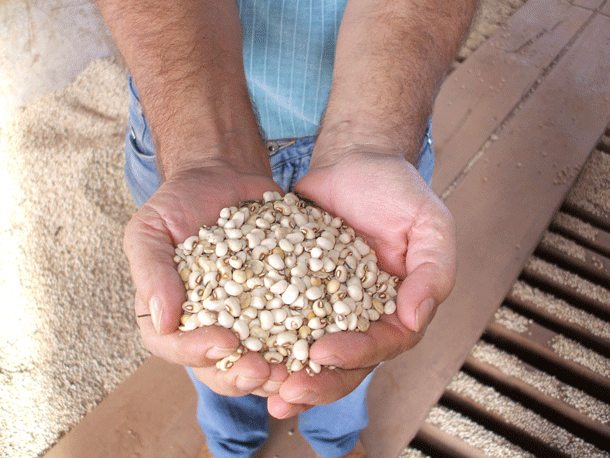
Once Amazon rainforest, this land is now cleared and ready to be planted with soy. (Photo: Bobby Bascomb)
Under California's cap and trade plan that starts in November, polluting companies will be able to buy carbon credits from tropical countries committed to REDD, Reducing Emissions from Deforestation and Degradation. Many environmental groups say that can protect tropical forests and reduce carbon dioxide emissions. We revisit a report on attempts to slow Brazil's deforestation by Living on Earth's Bobby Bascomb and Bruce Gellerman.
Transcript
CURWOOD: It’s Living on Earth, I'm Steve Curwood. REDD – the UN plan to reduce emissions from deforestation and degradation – is an attractive idea: have rich countries pay tropical forest nations to keep trees standing and soaking up carbon.
With the international Kyoto Climate Treaty stalled, Norway has done some REDD deals on its own in Brazil and Indonesia, and now California is getting ready to follow suit.
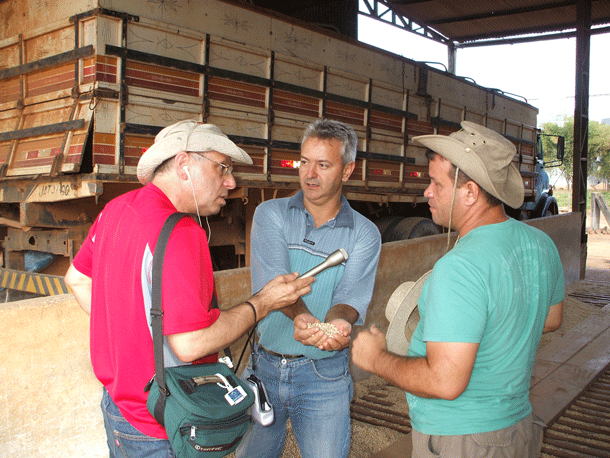
Soy farmer Jamar Brunier (center) with Bruce Gellerman (left) and Marco Lima (right) (Photo: Bobby Bascomb)
Critics of these efforts include Greenpeace. We’ll have more about California’s REDD plans just ahead, but first back to 2009. Living on Earth's Bruce Gellerman and Bobby Bascomb traveled to the Amazon to see tougher enforcement of forest protection in action. Along with their translator, Marco Lima, Bruce and Bobby met with John Carter, who's trying to ranch responsibly. Here's a portion of their report.
[PARADE SOUNDS AND MUSIC]
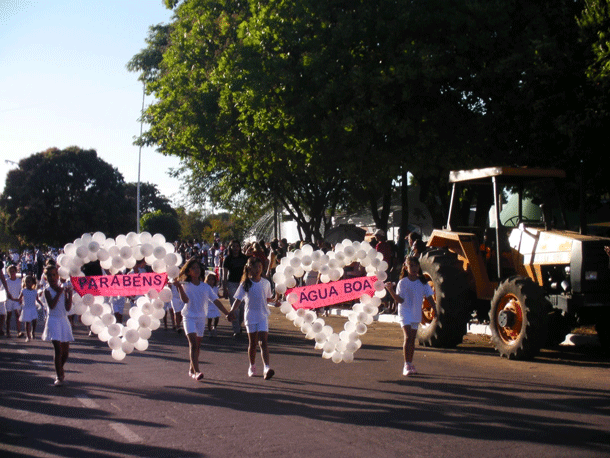
A parade in Agua Boa, Brazil’s beef growing heartland. (Photo: Bruce Gellerman)
BASCOMB: Marching bands commemorate the 30th anniversary of the city of Agua Boa. The boom town lies in the geographic heart of Brazil at the center of cow country. The place is perfect for agriculture: flat as Kansas but four times as large. What was once a forested frontier is now on the cutting edge of Brazil’s future, and fertile territory for John Carter and his Allianca de Terra – the Land Alliance.
[DRIVING SOUNDS]

John Carter pointing to his region of Brazil on a map. (Photo: Bruce Gellerman)
CARTER: Look over here, off to the east over here at around 11:00 - all that's our forest reserve.
BASCOMB: Carter drives us around his ranch. In this part of the Amazon, you’re supposed to keep half your land forested, but few follow the law. When Carter bought the place he decided to let 22 hundred acres regrow. He says that choice cost him more than a million dollars in lost productivity.
CARTER: And I let it come back to forest to come into compliance with the forest code.
BASCOMB: Do you regret doing that?
CARTER: I don't regret it, no. Personally I don't, but it was not a very wise decision. I don't get paid anything. I should be getting paid carbon credits for that. Two to three tons a year per hectare that's sequestering – that's a pretty good revenue stream for the ranch.
BASCOMB: The experience made John Carter one of the biggest cheerleaders for a REDD mechanism in Brazil. He founded the Land Alliance, and after convincing ranchers he wasn’t a CIA agent, signed up 160 Amazon farmers proving they could do better financially by doing good environmentally.
CARTER: We want to create mechanisms that puts a carrot out in front of the producer instead of a gun barrel behind his head.
BASCOMB: Since cattle are the force driving deforestation in the Amazon the Land Alliance hopes to put consumers in the driver’s seat.
GELLERMAN: Carter’s Land Alliance is creating a premium brand of beef, guaranteed not to come from deforested land, for which consumers would pay a premium price. In effect, a REDD mechanism for red meat. His organization has devised a vigorous certification system for member farmers.
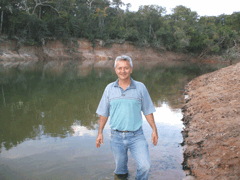
Farmer Jamar Brunier stands in a river that runs through his property. When colonists first settled the frontier the Brazilian government encouraged them to deforest all the river banks to reduce malaria. Now Land Alliance farmers like Jamar Brunier are reforesting riparian zones. (Photo: Bobby Bascomb)
CARTER: So he’s coming into our system, he’s taking off his clothes basically, he’s showing us his body and all the defects, and he’s allowing us to tell him what he needs to do to come back into compliance.
GELLERMAN: So the idea is to make the value of a standing forest more valuable than if you were going to cut it down and use if for cattle, soy beans, and so on?
CARTER: Absolutely. Our goal, hands down, is to buy time. More importantly, is that long-term goal, like you said, to make the standing forest at least almost comparable in value to the cleared forest. If it’s 30 percent as valuable as the cleared forest, we’re gonna have a tremendous impact. Doesn't have to be one to one. People sense that there’s a lot of goodwill and a lot of people that are willing to create a new model.
[BIRD SOUNDS]
GELLERMAN: Jamar Brunier is one of those people. Recently, Brunier joined Carter’s Land Alliance. 20 years ago, he and his wife migrated from the south of Brazil to Mato Grosso. They came with one suitcase each and a shared dream. Today, they own a grainery and 65 hundred acres of land.
BRUNIER: [Translation] When I bought this land I didn’t have any information from anyone. I simply came with a Caterpillar and we cleared everything here. Come look down here.
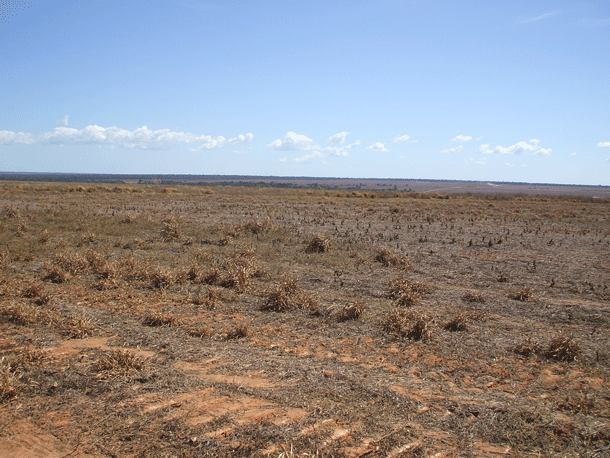
Once Amazon rainforest, this land is now cleared and ready to be planted with soy. (Photo: Bobby Bascomb)
[WALKING SOUNDS]
BRUNIER: [Translation] We simply cut, chopped down everything all the way to the river banks.
GELLERMAN: Land Alliance evaluators scrutinized satellite photos and visited Brunier’s farm. They found he had destroyed a thousand acres too much. They gave Brunier a report detailing what needed to be done and the technical expertise to come into compliance. More carrot, less stick.
BRUNIER: [Translation] Now with the help of the alliance they came here and told us what to do and before the government comes here and fine me, I’m going to start to replant with the original woods from here. I will do the reforestry.
GELLERMAN: Would you have known that without the Land Alliance?
BRUNIER: [Translation] No, I was going to be fined by the government such a fine that I would never have money to pay. I was going to go bankrupt.
[BIRD SOUNDS]
GELLERMAN: But these days it’s not the government that worries farmer Jamar Brunier the most – it’s a non-governmental organization: Greenpeace. The NGO’s scathing report “Slaughtering the Amazon” blames farmers like Brunier for destroying the forest.
BRUNIER: [Translation] If NGO’s come here to accuse us, what are they going to do? We’ve been doing things right. I will tell Greenpeace my water is clean.
GELLERMAN: What would you like to tell Greenpeace?
BRUNIER: [Translation] I really want to tell the guys from Greenpeace that they need to know from where the food come from – from where the butter comes from, where the food their kids eat comes from. And I cry because no one comes to hear us what we want to say. They only come here to spank us. That’s why I’m crying.
BRUNIER: [Translation] Our intentions are good.
GELLERMAN: Says Amazon farmer Jamar Brunier.
[MUSIC: Jose DaLouis Alenca, recorded on location in Para Brazil by the LOE producers.]
CURWOOD: Bruce Gellerman and Bobby Bascomb in Brazil in 2009. Well, that farmer, Jamar Brunier, might have another beef with Greenpeace today. The organization has long promoted conservation but it recently criticized sub-national REDD projects in a report called, “Outsourcing Hot Air.” Greenpeace says these REDD projects may do little to cut pollution.
Links
Greenpeace Report “Outsourcing Hot Air.”
Dan Nepstad’s Response to the Greenpeace Report
Living on Earth wants to hear from you!
Living on Earth
62 Calef Highway, Suite 212
Lee, NH 03861
Telephone: 617-287-4121
E-mail: comments@loe.org
Newsletter [Click here]
Donate to Living on Earth!
Living on Earth is an independent media program and relies entirely on contributions from listeners and institutions supporting public service. Please donate now to preserve an independent environmental voice.
NewsletterLiving on Earth offers a weekly delivery of the show's rundown to your mailbox. Sign up for our newsletter today!
 Sailors For The Sea: Be the change you want to sea.
Sailors For The Sea: Be the change you want to sea.
 The Grantham Foundation for the Protection of the Environment: Committed to protecting and improving the health of the global environment.
The Grantham Foundation for the Protection of the Environment: Committed to protecting and improving the health of the global environment.
 Contribute to Living on Earth and receive, as our gift to you, an archival print of one of Mark Seth Lender's extraordinary wildlife photographs. Follow the link to see Mark's current collection of photographs.
Contribute to Living on Earth and receive, as our gift to you, an archival print of one of Mark Seth Lender's extraordinary wildlife photographs. Follow the link to see Mark's current collection of photographs.
 Buy a signed copy of Mark Seth Lender's book Smeagull the Seagull & support Living on Earth
Buy a signed copy of Mark Seth Lender's book Smeagull the Seagull & support Living on Earth

